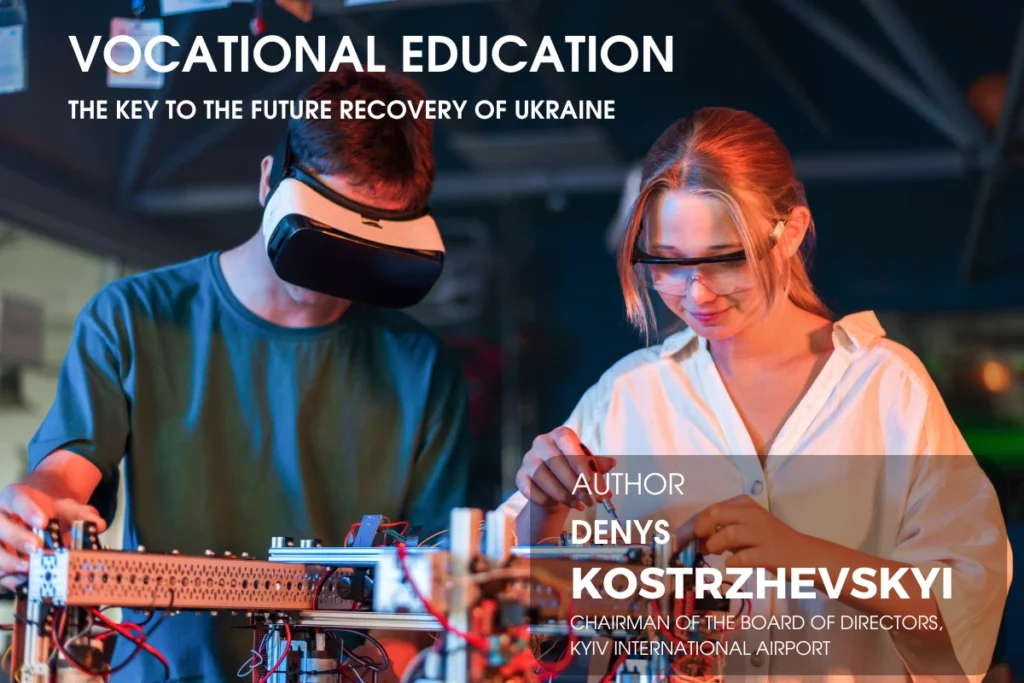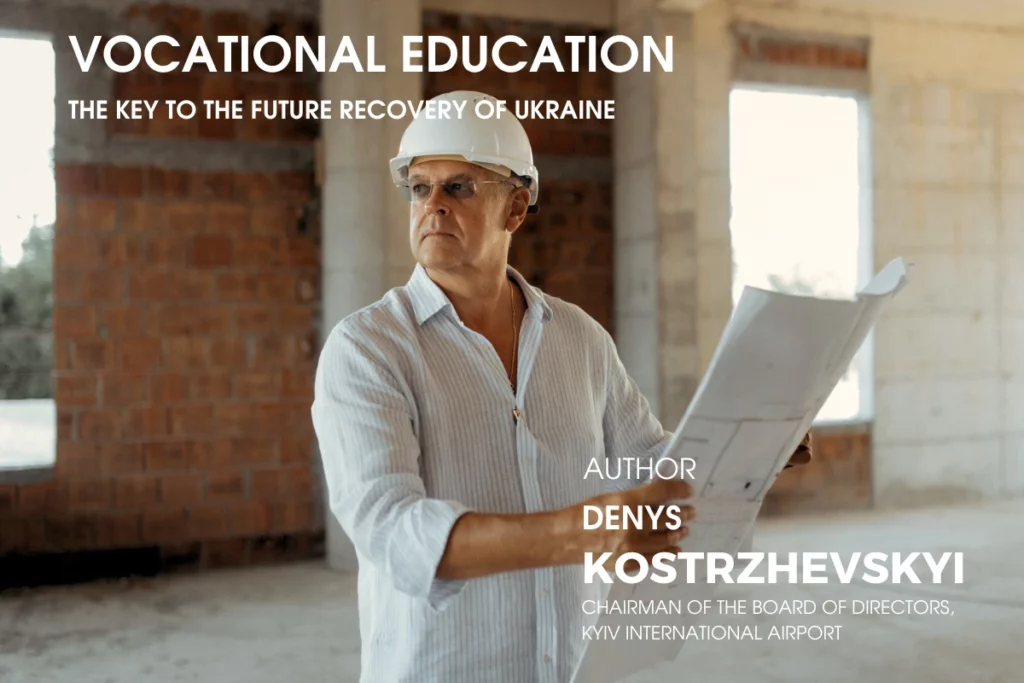Denys Kostrzhevskyi. Vocational Education: The Key to Ukraine’s Future Recovery
Ukraine is facing massive challenges caused by the war, which has destroyed infrastructure and jobs. Today, more than ever, the rapid training of young professionals for the country’s reconstruction is crucial, and vocational education is becoming a vital tool in this process.
Vocational education allows for the swift training of specialists capable of immediately contributing to the rebuilding of cities and infrastructure. Practical skills acquired during training ensure immediate application in real production settings. There is no longer time for lengthy theoretical programs — the country needs practical knowledge for reconstruction today.
Linking Vocational Education to Industry
The effectiveness of vocational education depends on close cooperation with businesses. Students must acquire practical skills directly at production sites, which will allow them to be job-ready immediately upon graduation.
Post-war experiences in other countries confirm this effectiveness. For example, in post-war Britain and the Soviet Union, short-term educational programs provided young people with practical skills to work in the reconstruction of factories and infrastructure, ensuring rapid economic recovery.

Industrial Parks: Creating Conditions for Revival
To make vocational education as effective as possible and aligned with the needs of the real economy, it is important to establish special industrial parks. These are not just clusters of businesses but entire ecosystems where production facilities, educational bases, and research centers coexist on one site. This approach allows students to not only receive theoretical knowledge but also immediately immerse themselves in real production conditions, honing their skills while working at modern enterprises.
The organization of such parks with state support, particularly in regions where active production and infrastructure development are planned, will be a key step in Ukraine’s recovery. This will create favorable conditions for the training, employment, and development of young professionals. Industrial parks could become platforms where young specialists not only study but also gain real-world experience at companies actively working on restoring the country’s infrastructure.
For Ukraine, this path could be one of the most effective. Industrial parks will not only prepare qualified specialists but also serve as a foundation for long-term economic growth and the country’s integration into the global economy. In such parks, everything is combined: from education to real working conditions, from theory to practice. This is a model that ensures a stable future.
Examples of Post-War Recovery
After World War II, Germany quickly restored its infrastructure through economic reforms and investments in vocational education. The industrial parks created at that time became the foundation for the country’s progressive development. A similar approach could be applied in Ukraine, where international investors, in collaboration with local businesses, would help restore the economy and contribute to the development of highly qualified personnel.
Following World War II, Germany focused its efforts on reviving heavy industry in the Ruhr region, which before the war had been a center for coal mining and metallurgy. To accelerate recovery, international investments were attracted, as well as support through the Marshall Plan. The creation of industrial parks concentrated resources and technologies for the rapid restoration of factories and the introduction of new technologies. This led to an economic boom and solidified Germany as a leader in steel and engineering production.

European Experience in Vocational Education
Ukraine is not alone in seeking effective solutions for developing vocational education. Many European countries have long tested various models, and their success presents a great opportunity for us to learn and adopt the best practices. There are many to look up to.
Germany is one of the brightest examples of a successful dual education system, which has become the true foundation of the country’s economic success. The essence of this system lies in the fact that students simultaneously study at educational institutions and work at real enterprises. This not only provides them with practical experience but also immediately integrates them into the labor market. As a result, youth unemployment in Germany is as low as 6%.
The government supports this system by providing tax incentives to companies: they can reduce their corporate tax by up to 25% of the costs associated with training students and reimburse up to 50% of the cost of training one student. And this yields real results — more than 50% of graduates choose vocational education, ensuring themselves employment immediately after graduation.
Switzerland demonstrates another successful example, combining state and private sector support. Here, companies receive subsidies for training students, covering up to 50%, and students can count on scholarships. Thanks to this system, over 60% of young people choose vocational education, and the country provides itself with qualified personnel for high-tech industries. Youth unemployment here is only 3%.
Austria has decided to actively support businesses that engage students in practical training. Companies receive up to €5,000 per year in compensation for each student they train. This encourages companies to take an active part in the educational process, which in turn improves the quality of specialist training. Thanks to these measures, the number of students in vocational schools has increased by 15% over the past five years, and youth unemployment has fallen to 7%.

Miskzhitlobud Construction Company: Vocational Education as a Foundation for the Development of Young Professionals
Even before the war, a number of construction companies in Ukraine actively involved young talent in their enterprises, preparing the future workforce. A prime example is the Kyiv-based construction company Miskzhitlobud, which collaborated with students from the Kyiv National University of Construction and Architecture (KNUBA), involving them in project work and practical training on construction sites.
Students not only gained theoretical knowledge but also had the opportunity to immediately apply it to real construction projects, developing their skills and gaining valuable practical experience.
In the case of Miskzhitlobud, the company had the opportunity to nurture future talent, involving students early in their careers. This helped form a future talent pool that was not only technically knowledgeable but also familiar with the corporate culture and philosophy of Miskzhitlobud. Graduates who underwent such training became full-fledged members of the larger team, adapted to the demands of the modern market and ready for the challenges of their profession.
This model of integrating students into the production process also contributes to raising the overall level of vocational education. It not only provides a theoretical foundation but also allows students to immediately see how their knowledge can be applied in practice. This reduces fear of new technologies and facilitates the faster adoption of the latest production processes, which are key to the recovery and development of Ukraine’s infrastructure after the war.
Such an approach to education and employment of construction students will enable Ukraine to create a generation of professionals capable of quickly adapting to market demands and becoming an essential resource for the country’s reconstruction and modernization.
Legislative Changes for the Development of Vocational Education
Amid the current challenges facing Ukraine, vocational education can become a crucial support for the rapid recovery of the economy. However, this cannot be achieved without a clear strategy and systematic changes at the legislative level. What needs to be done to ensure that vocational education truly benefits the country?
First, one of the key conditions for the successful integration of vocational education into the economy is business support. European experience shows that businesses are willing to invest in workforce training if they receive appropriate state support. In Ukraine, this can be implemented through changes to the Tax Code. Companies should be allowed to deduct the costs of student training from their gross expenses, reducing their tax base.
This could include the costs of paying instructors, materials, and equipment for practical training, among others.
Additionally, tax incentives can become a powerful motivator for businesses. For example, companies that collaborate with vocational schools and accept students for internships could be offered a corporate tax reduction of 10-20%. Such a system of tax benefits would significantly reduce business costs and become a driver for attracting young people to production training.
Another effective tool is cost reimbursement: the state could compensate up to 50% of the costs of student training through a reimbursement mechanism. This model is successfully applied in Germany and Austria, where companies participating in workforce training receive financial support for each student who undergoes practical training with them.
Second, legislative changes are needed in the education system itself. The current Education Act needs to be updated to better meet the modern challenges of the labor market. The dual education system, which already exists in Ukraine, faces numerous challenges due to overregulation. The development, approval, and coordination of individual training plans for each student takes a significant amount of time, leading to the obsolescence of training programs before they are even implemented.
This system needs to be simplified and modernized. Changes to the legislation are necessary to accelerate the plan approval process and make the system more flexible. This can be achieved by either updating the current law or adopting a new law on vocational education, which will clearly define the mechanisms of cooperation between educational institutions and businesses and ensure the relevance and effectiveness of the dual system.
Such a law should also provide state scholarships for students, especially those who choose strategically important fields for the country — construction, infrastructure, and energy. This financial support will make vocational education more attractive to young people, increasing its competitiveness compared to university education.
Third, the state can support business and education by creating industrial parks. They would unite companies, educational institutions, and research institutes, ensuring constant interaction between all labor market participants. Global experience shows that industrial parks can have additional benefits if they operate within free economic zones or are subject to a special tax regime.
For example, such zones could have preferential taxation or a system of localized tax collection, where taxes collected within the parks are reinvested into the region for its development.
In general, legislative initiatives should aim to create conditions where vocational education becomes integrated into Ukraine’s economic landscape. However, all changes to laws and regulations must be synchronized with a comprehensive strategy for the reform of vocational education, which must be adopted first.
A strategy must first be developed that outlines the main directions for vocational education reform, which will serve as a roadmap for making legislative changes and implementing them. This process is the responsibility of the Cabinet of Ministers of Ukraine, which must coordinate such important, strategic reforms.
Author: Denys Kostrzhevskyi, Chairman of the Board of Directors, Kyiv International Airport
